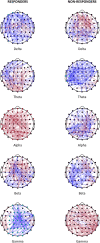Estimated EEG functional connectivity and aperiodic component induced by vagal nerve stimulation in patients with drug-resistant epilepsy
- PMID: 36504670
- PMCID: PMC9728998
- DOI: 10.3389/fneur.2022.1030118
Estimated EEG functional connectivity and aperiodic component induced by vagal nerve stimulation in patients with drug-resistant epilepsy
Abstract
Background: Vagal nerve stimulation (VNS) improves seizure frequency and quality of life in patients with drug-resistant epilepsy (DRE), although the exact mechanism is not fully understood. Previous studies have evaluated the effect of VNS on functional connectivity using the phase lag index (PLI), but none has analyzed its effect on EEG aperiodic parameters (offset and exponent), which are highly conserved and related to physiological functions.
Objective: This study aimed to evaluate the effect of VNS on PLI and aperiodic parameters and infer whether these changes correlate with clinical responses in subjects with DRE.
Materials and methods: PLI, exponent, and offset were derived for each epoch (and each frequency band for PLI), on scalp-derived 64-channel EEG traces of 10 subjects with DRE, recorded before and 1 year after VNS. PLI, exponent, and offset were compared before and after VNS for each patient on a global basis, individual scalp regions, and channels and separately in responders and non-responders. A correlation analysis was performed between global changes in PLI and aperiodic parameters and clinical response.
Results: PLI (global and regional) decreased after VNS for gamma and delta bands and increased for an alpha band in responders, but it was not modified in non-responders. Aperiodic parameters after VNS showed an opposite trend in responders vs. non-responders: both were reduced in responders after VNS, but they were increased in non-responders. Changes in aperiodic parameters correlated with the clinical response.
Conclusion: This study explored the action of VNS therapy from a new perspective and identified EEG aperiodic parameters as a new and promising method to analyze the efficacy of neuromodulation.
Keywords: EEG; aperiodic component; drug-resistant epilepsy (DRE); functional connectivity (Fc); vagus nerve stimulation (VNS).
Copyright © 2022 Coa, La Cava, Baldazzi, Polizzi, Pinna, Conti, Defazio, Pani and Puligheddu.
Conflict of interest statement
Unrelated to this study, in the past 3 years, Author RC received support for congress attendance from a distributor of VNS therapy and Author MP had a consulting contract with Livanova, USA. The remaining authors declare that the research was conducted in the absence of any commercial or financial relationships that could be construed as a potential conflict of interest.
Figures



Similar articles
-
Long-term effects of vagus nerve stimulation on EEG aperiodic components in patients with drug-resistant epilepsy.Ther Adv Neurol Disord. 2024 Sep 25;17:17562864241279124. doi: 10.1177/17562864241279124. eCollection 2024. Ther Adv Neurol Disord. 2024. PMID: 39371641 Free PMC article.
-
The Effectiveness of Vagus Nerve Stimulation in Drug-Resistant Epilepsy Correlates with Vagus Nerve Stimulation-Induced Electroencephalography Desynchronization.Brain Connect. 2020 Dec;10(10):566-577. doi: 10.1089/brain.2020.0798. Epub 2020 Nov 18. Brain Connect. 2020. PMID: 33073582 Free PMC article.
-
Responders to vagus nerve stimulation (VNS) in refractory epilepsy have reduced interictal cortical synchronicity on scalp EEG.Epilepsy Res. 2015 Jul;113:98-103. doi: 10.1016/j.eplepsyres.2015.03.018. Epub 2015 Apr 9. Epilepsy Res. 2015. PMID: 25986196
-
Latest Views on the Mechanisms of Action of Surgically Implanted Cervical Vagal Nerve Stimulation in Epilepsy.Neuromodulation. 2023 Apr;26(3):498-506. doi: 10.1016/j.neurom.2022.08.447. Epub 2022 Sep 2. Neuromodulation. 2023. PMID: 36064522 Review.
-
[Application of scalp electroencephalogram in treatment of refractory epilepsy with vagus nerve stimulation].Sheng Wu Yi Xue Gong Cheng Xue Za Zhi. 2020 Aug 25;37(4):699-707. doi: 10.7507/1001-5515.201909002. Sheng Wu Yi Xue Gong Cheng Xue Za Zhi. 2020. PMID: 32840088 Free PMC article. Review. Chinese.
Cited by
-
Neuromodulation in new-onset refractory status epilepticus.Front Neurol. 2023 Jun 14;14:1195844. doi: 10.3389/fneur.2023.1195844. eCollection 2023. Front Neurol. 2023. PMID: 37388544 Free PMC article.
-
Brain functional connectivity and network characteristics changes after vagus nerve stimulation in patients with refractory epilepsy.Transl Neurosci. 2023 Sep 7;14(1):20220308. doi: 10.1515/tnsci-2022-0308. eCollection 2023 Jan 1. Transl Neurosci. 2023. PMID: 37719745 Free PMC article.
-
Vagus nerve stimulation for epilepsy: A narrative review of factors predictive of response.Epilepsia. 2024 Dec;65(12):3441-3456. doi: 10.1111/epi.18153. Epub 2024 Oct 16. Epilepsia. 2024. PMID: 39412361 Free PMC article. Review.
-
Long-term effects of vagus nerve stimulation on EEG aperiodic components in patients with drug-resistant epilepsy.Ther Adv Neurol Disord. 2024 Sep 25;17:17562864241279124. doi: 10.1177/17562864241279124. eCollection 2024. Ther Adv Neurol Disord. 2024. PMID: 39371641 Free PMC article.
-
Chronic intracranial recordings after resection for epilepsy reveal a "running down" of epileptiform activity.Epilepsia. 2023 Jul;64(7):e135-e142. doi: 10.1111/epi.17645. Epub 2023 May 19. Epilepsia. 2023. PMID: 37163225 Free PMC article.
References
-
- Wasade VS, Schultz L, Mohanarangan K, Gaddam A, Schwalb JM, Spanaki-Varelas M. Long-Term Seizure Psychosocial Outcomes of Vagus Nerve Stimulation for Intractable Epilepsy. (2015). Available online at: https://ac.els-cdn.com/S1525505015005533/1-s2.0-S1525505015005533-main.p... (accessed March 11, 2018). - PubMed
LinkOut - more resources
Full Text Sources
Miscellaneous

